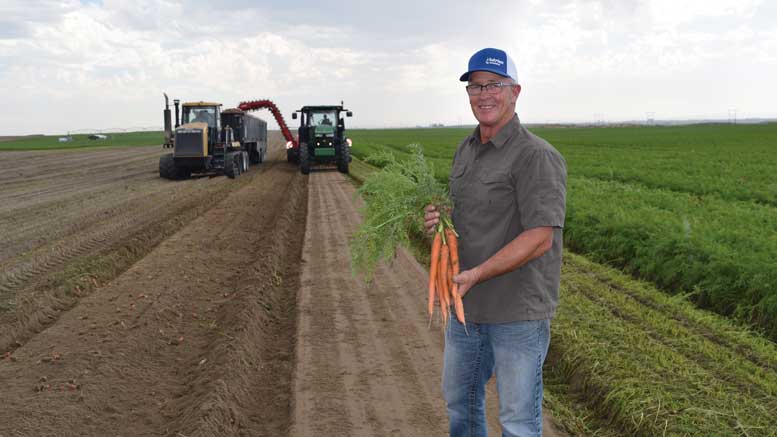|
Click to listen to this article
|
Story and photos by Denise Keller, Editor
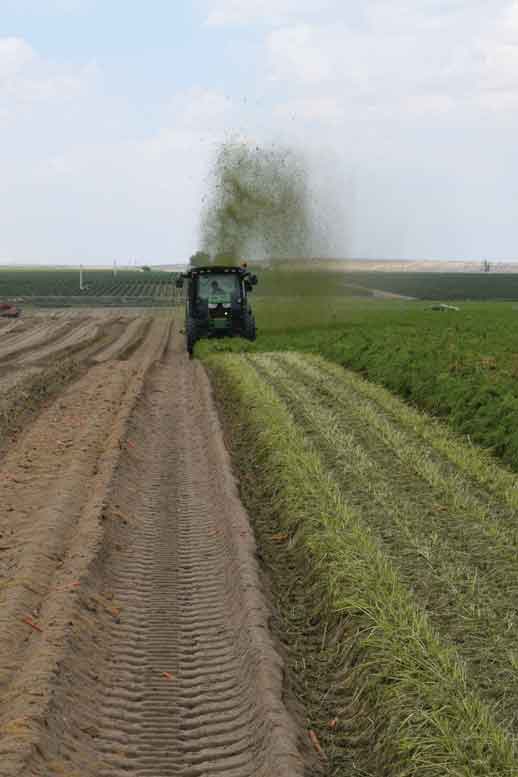
When it comes to growing carrots for the frozen process market, Jim Klaustermeyer Jr. says it’s a lot like baseball.
“The crop is all grown for contract; there’s no open market,” Klaustermeyer says. “I use the analogy of hitting singles and doubles. There are no homeruns. But you are in the game all the time.”
Klaustermeyer has been in the game since 1989, when he returned from college to farm with his dad in Basin City, Washington. Jim Klaustermeyer Sr., who remains involved in the day-to-day operation of the farm, had been a crop science professor at California Polytechnic State University, San Luis Obispo, before moving to the Columbia Basin in the late 1970s to farm with other growers and, ultimately, start Klaustermeyer Farms in 1986.
“I like to say that he came up to Washington to practice what he preached,” Jim Klaustermeyer Jr. says of his dad.
When the younger Klaustermeyer joined his dad in the operation, they were farming 300 to 500 acres. Today, they grow 2,000 acres of carrots for processing, along with a couple hundred acres of pearl onions and 500 to 700 acres of rotation crops including wheat, beans and hay. Klaustermeyer attributes much of the farm’s steady growth in the 1990s to its implementation of a method of crowning carrots in the planting bed.
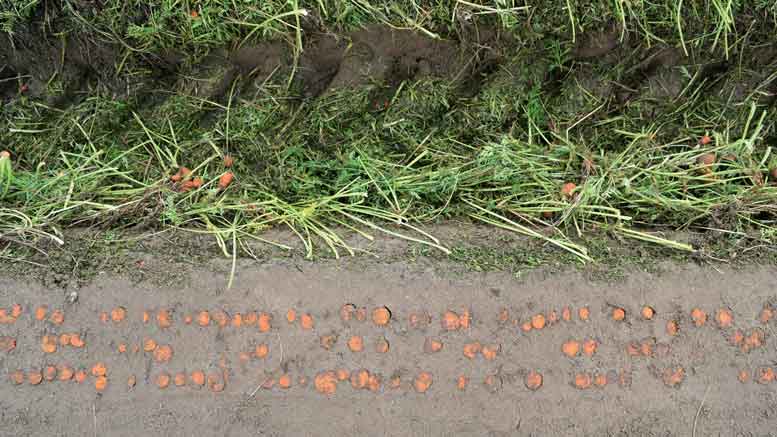
Crowning the Carrots
After harvesting the first several carrot crops with a top lifter, Klaustermeyer Farms transitioned to planting carrots in wider beds and share-lifting the crop. When the processor requested that the farm begin crowning the carrots in the early to mid ‘90s, the Klaustermeyers modified their harvest process. After topping the carrots, the growers began using a homebuilt implement to crown the carrots before share-lifting the crop. The technology had been adopted in Europe and commercial crowners were being built, Klaustermeyer says. Since then, the practice has become common in processing carrots.
“When we developed the crowning technique, it was a big labor savings for the processors. They were taking the crowns off the carrots manually, and in order to save them some labor and add value to our product, we developed this crowning technique,” Klaustermeyer recounts. “I remember pretty vividly the first year that we did that, the comment back from the processor was ‘We were able to remove up to 30 people from the line.’ It was a cost savings for them and a value-added step for us.”
Klaustermeyer’s contract calls for 90 percent of the carrots to be crowned. Therefore, depending on how they’re growing in the bed, some will be topped more aggressively than others. Careful management is needed to remove the minimal amount of the carrot and still meet the contract requirements. Even under ideal conditions, crowning reduces yield by about 12 percent.
On the flipside, crowning the carrots in the beds means that top attachment is not nearly as critical, Klaustermeyer says. This allows the grower to fight diseases with chemicals that could weaken top attachment later in the season and allows him to select varieties for attributes other than top attachment, prioritizing durability to withstand the more aggressive harvest process, followed by color and taste. He also seeks out cultivars that stay flush with the soil surface rather than protruding out of the bed, in an attempt to minimize the amount of carrot lost during crowning.
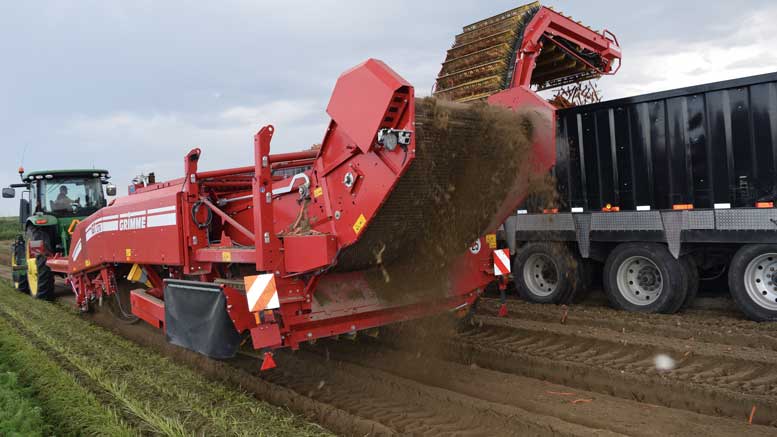
Managing the Crop
Through the years, Klaustermeyer has seen the number of carrot growers in the region decrease and each grower’s acreage increase as consolidation reshaped the industry.
“We were at the right place at the right time to grow with it, and now we’re able to keep up with a pretty robust harvest demand,” the grower says.
Klaustermeyer Farms grows 1,100 acres of slicer-type carrots, 400 acres of dicers, 200 acres of cut-and-peel carrots, 250 acres of yellow carrots and 50 acres of “natural baby carrots.” The farm takes advantage of the Columbia Basin’s extended growing season. Planting starts mid-March and continues through the first week of June, while harvest extends from the third week of July through Thanksgiving. The long planting window keeps carrots – especially slicers – at the proper maturity, but also adds complexity to managing the crop.
“We’re planting so long that we’re managing a different size crop throughout the season. By that, I mean in August, I still have carrots that are very small and I have carrots that are ready to harvest,” the grower explains. “You can’t just say ‘It’s August 15, so I do this.’ Until early fall, the carrots are at so many different levels of maturity that you have to be on your toes to keep up with the different stages of growth the carrots are in.”
With more than 30 years of experience, Klaustermeyer has learned to manage the various challenges in growing carrots, from pests to pathogens. Carrots are grown on a four-year rotation, and the grower considers the crop produced in the field the previous season, preferring to follow wheat, onions, timothy hay or beans.
With a diverse range of soil types in the Columbia Basin, Klaustermeyer also chooses to plant carrots in sandy or sandy loam soil. This makes for better harvest conditions and fewer dirt clods in the load compared to farming in heavier soil. At the same time, however, sandy fields are more vulnerable to wind erosion. After a year in which a 40-hour windstorm took out 500 acres of carrots, Klaustermeyer adopted a cover crop system, now sowing wheat between rows of carrots. The wheat, emerging more quickly than early-season carrots, provides erosion protection before being killed with a selective herbicide when carrots reach the two- to three-leaf stage.
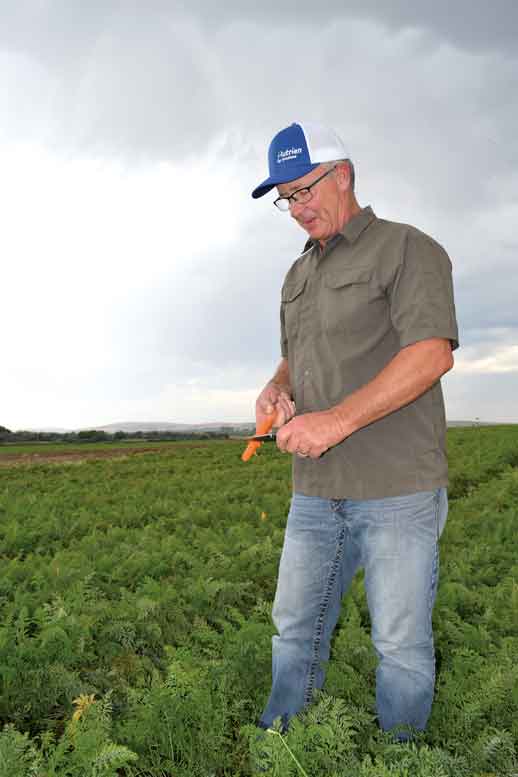
Seeing the Progress
Looking ahead, Klaustermeyer sees the importance of efficiency on the farm. Although the industry is already fairly automated, higher production costs and new labor laws in Washington state will likely lead to more mechanization. The grower also expects new carrot cultivars to be developed and hopes the new releases might include varieties that grow more evenly across the bed in order to increase crowning uniformity.
For now, Klaustermeyer appreciates the opportunity to farm with his dad and values the contributions of his crew, including employees who have been on the farm for 20 to 25 years.
“I really enjoy working in the dirt and being able to measure my progress daily. I have a great crew that helps me accomplish this every day,” he says.

